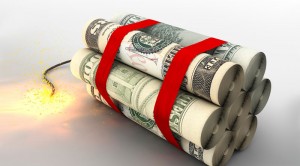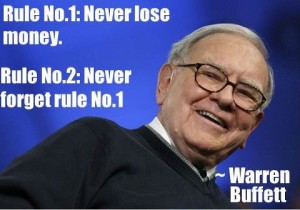Staying Rich by Not Losing Money
There are some people out there that dislike losing so much that they would say they hate to lose more than the like to win. These are the people that usually end up being the most successful in their endeavors and achieve greatness. But regardless whether someone is that fervent on the subject or if they are just passive, one thing remains consistent, and that’s the fact that people don’t like losing; they hate losing money even more.
What is the first thing that comes to mind after you lose? Your mind probably fills with a smorgasbord of emotions: disappointment, anger, sadness, and malcontent amongst others. But one thing that many people feel is the humiliation fueled need to avenge this loss. It’s the need to try again. It’s the need to recoup what we’ve lost and, not only win, but at least, to bring us back to even; making us whole. This concept gets very interesting when talking about money.
All value investors have, at one time or another, heard the famous quote from Warren Buffet: “Rule One: Never Lose Money. Rule Two: Never Forget Rule One”. But what does this mean? Isn’t it obvious not to lose money? I mean, who actually wants to lose money? This should be a clear and common understanding, no? Obviously the second rule is there to reinforce how absolutely important rule #1 is. But why is rule #1 so important?
This is a very fundamental concept but you’ll be surprised by the results, as obvious as they may seem. Let’s start with holding period return (HPR). HPR is simply the return that is made. It’s the amount of money that was earned expressed as a percentage of what was invested. The formula to calculate this is simple: just take the final amount of money and divide it by the amount that was invested and then subtract 1. So, for example if, as an investment, you end up with $130 and you invested $80, then the HPR is (130/80)-1 = 0.625, or 62.5%. This means that you made 62.5% on your investment of $80. The same calculation works if you lose money. Starting with $100 and ending up with $80, your HPR is (80/100)-1 = -0.20, or a loss of 20%.
Let’s take this concept of losing money a little further: Start with 100 hypothetical dollars. If you lose $10 you’ve lost 10%. If you lose $20 you’ve lost 20%. If you lose $50 you’ve lost 50%. Now, assume that you’ve taken the loss and you’re looking to continue investing; investing isn’t a one time thing and typically people do it more than once, especially since they’ve lost some money – now they want to earn it back. If you lost 10%, or $10, you are now left with $90 to start investing with. Well how much do you need to earn in order to get back to $100? 10%? Incorrect! You need to earn 11% to get back the original $100. This is because now your denominator in the HPR equation is different. You’re no longer starting with $100; you’re starting with $90. HPR = (100/90)-1 = 0.11 or 11%. Interesting isn’t it? Take a look at the chart below and observe how fast this compounds.
| If you lose: | Percentage Lost: | Percentage to Regain: |
| $10 | 10% | 11% |
| $20 | 20% | 25% |
| $50 | 50% | 100% |
| $75 | 75% | 300% |
| $90 | 90% | 900% |
It’s staggering to see how a small loss of money requires relatively significant gains to rebuild the portfolio. How often does an investor see a 50% loss? It happens much more frequently than the 100% gain it takes to rebuild, that’s most definite.
This is exactly what Warren Buffet meant by his two-rule quote. Investors should do whatever possible not to lose money. The absence of making money is better than the loss of money. Although a subject for another time, Warren Buffet himself hasn’t steered clear of losses; the purpose behind the quote is not so much an investing lesson, as it is a lesson in emotions. It’s an attitude towards money and the discipline behind it. Investing money isn’t a game. The money that is used isn’t fake monopoly cash or immaterial Canadian Tire dollars. This is real cash, that, when lost, can take eons to regain, if ever. Even the super rich investor who, seemingly, has little regard for his money, is somewhat disciplined in how he spends it, because at one point that money was just a handful of dimes, and every loss was equal to an inevitable uphill struggle to rebuild.
As value investors we must remain disciplined in our art and in our emotions. We must separate the desire to make irrational investments and focus on the facts. Otherwise we would be taking risks that could cause us to lose money. And, as shown above, losing money isn’t all that attractive to deal with.









